Nothing Represents Mazda’s Zoom Zoom Era Like the RX-8
Do you remember Zoom Zoom?
Maybe the more pertinent question is whether anyone’s forgotten it. Mazda’s joyous, playful slogan from 2001 to 2015 wormed its way into countless ears. It promised above all a pure, fun driving experience, and it was more than a cheerful jingle. During this period Mazda took Zoom Zoom to heart, filling their lineup with affordable cars that delivered serious sporting chops and unforgettable personality. None of them did so in a fashion quite as uniquely Mazda as the RX-8.
During its production, but even more noticeably in today’s turbo two-liter-dominated world, the RX-8 approaches nearly everything differently from other sports cars. That ethos is rooted in its engine.
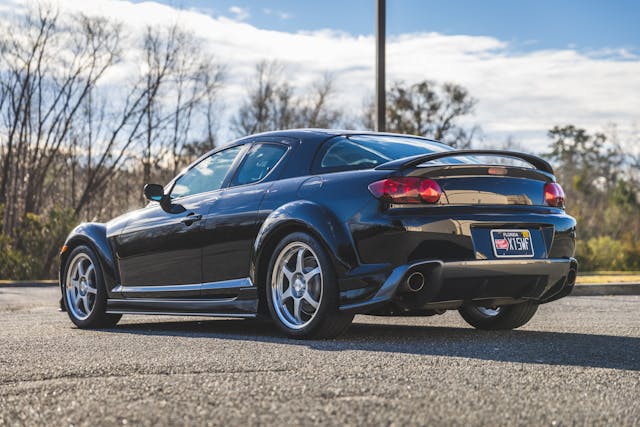
Wankel rotary engines have been in Mazda’s DNA since 1963’s Cosmo prototype. Compact and powerful for its displacement, the engine intrigued several manufacturers but only took off with any real success at Mazda. The company continually improved the design, steadfastly sticking with it for decades. They placed it under the hoods of everything from the entry-level RX-3 to larger sedans like the Luce (known as the 929 in the U.S., though we didn’t get the rotary version), and, of course, three generations of the RX-7. For over twenty years, Mazda built its sporty identity around the rev-happy, punch-above-its-weight rotary sports car.
Though the RX-7 left the U.S. after 1995, Mazda had another rotary ride up its sleeve. Debuting stateside in 2004, Mazda went all-in: The RX-8’s rotary-themed personality was impossible to miss. Design elements of the nose, hood, tail, shifter, dash, seats, handbrake—just about everything references the engine. The athletic RX-8 isn’t beautiful like the final-gen RX-7, but no one would ever call the newer car derivative.
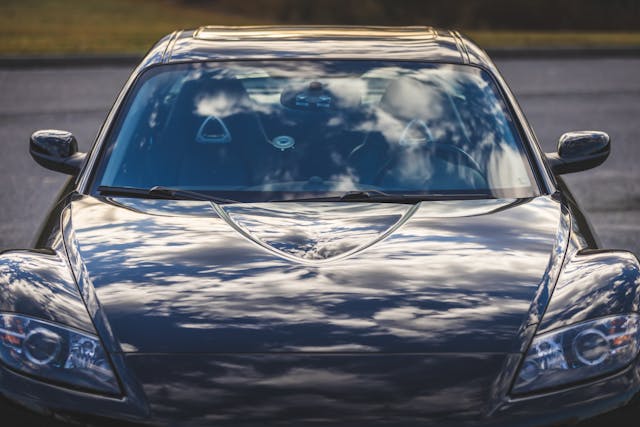
Underneath the curvaceous bodywork runs another bit of Mazda DNA: a perfectly tuned chassis. It wasn’t five minutes into my drive of this 2004 RX-8 (available on Hagerty Marketplace) that I felt fully attuned to the car and ready to push it harder. The sensation is incredibly familiar, like a longer-wheelbase, higher-threshold third-generation Miata.
There’s less body roll in the RX-8 than its smaller sibling, and the handling dynamics are sharp but not snappy—this is an inherently friendly, tactile car. These traits are amplified in this particular example, which benefits from a host of suspension upgrades from brands that will be familiar to anyone who knows a little about the Japanese tuner world—Tein, Racing Beat, and Mazdaspeed (Mazda’s in-house tuner and racing parts entity).
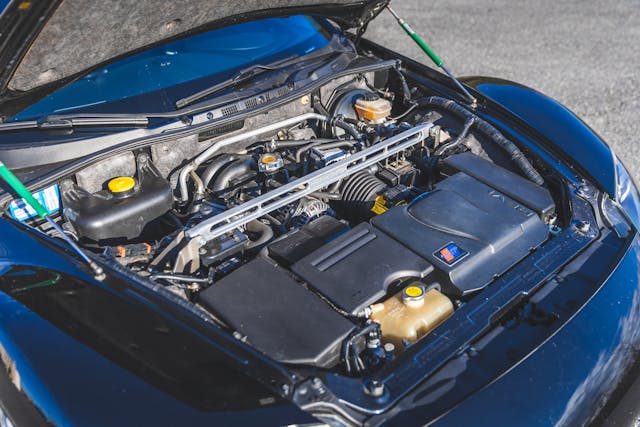
The 9000-rpm screamer of a 1.3-liter RENESIS twin-rotor engine pairs perfectly with this chassis and sounds like nothing else. That’s no exaggeration—a rotary wail, even through factory exhaust, is one of those notes that never stops willing you to push for the redline. And, short of SCCA classes that are friendly to RX-7s and RX-8s, you won’t find yourself in too many scenarios in which another car plays the same song.
If anyone asks how much power the RX-8 has, the proper answer is enough (238 hp). If they ask for the torque figure (159 lb-ft), you can pivot and compliment their loafers. (Those figures are for the manual-equipped cars; the automatics made do with 197 hp and a slightly higher 164 lb-ft of torque.) Truth be told, the car is quick, and from 4000 rpm on up there’s plenty on tap. In accordance with its Zoom Zoom roots, the RX-8’s power delivery gives you more than enough to balance the car with the throttle, but not so much that you think the car is going to bite you.
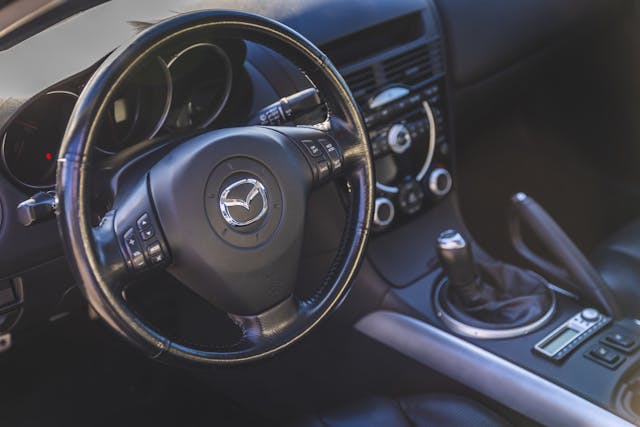
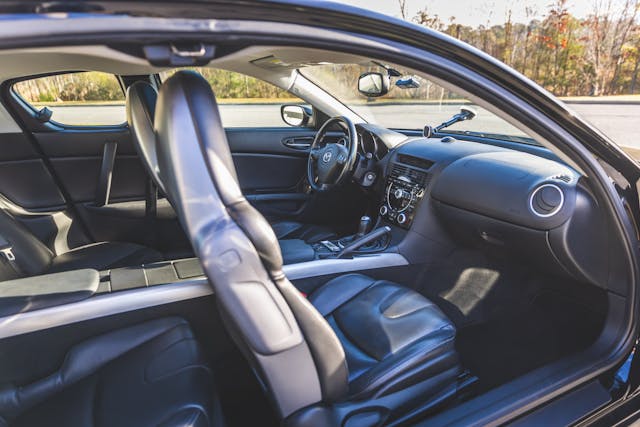
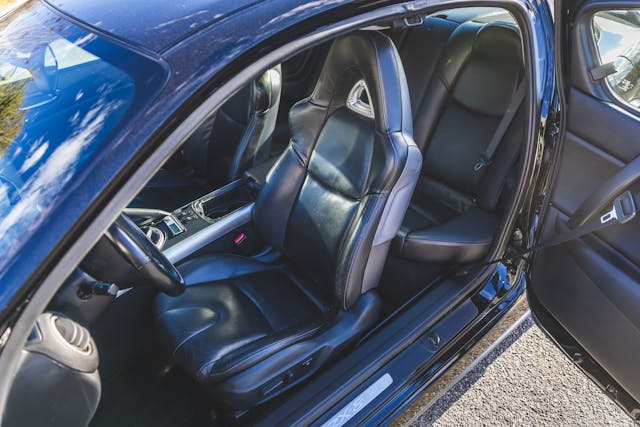
Inside, the priority on driving experience is apparent in the RX-8’s cockpit and controls. The steering is tight, communicative, and well-weighted; the shifter crisply moves between gears and is short in height and throw. The pedal box offers ample room, the pedals positioned perfectly for heel-toe work. The well-bolstered buckets naturally integrate a rotary-themed triangle hole in the headrest, and successfully balance effective cornering support and long-distance comfort. Ahead of you sits a simple triple-ringed gauge cluster that puts a big tach front and center, and an at-a-glance digital speed readout beneath.
Look past the shallow dashboard, and the car’s lithe proportions enable you to position it with confidence. In your periphery, though, the cabin can feel a bit bunker-like, with the car’s thick C-pillars hampering three-quarter visibility.
Overall, the cabin feels trim and hospitable. The plastics used in the RX-8 hold up reasonably well if they’ve been cared for. They’re of good quality (although there is a bit of piano black swathed on the doors and dash), and the dashboard layout is old enough that it doesn’t have any awkward and obsolete early-screen tech.

The RX-8 will happily accommodate a good-sized grocery run or luggage for a lengthy road trip. The backward-opening rear doors—another departure from sports car norms—provide good access to the second row of seats, which effectively serve as the primary storage area given the trunk’s petite dimensions. Whether its interior is too small or just right is a matter of perspective—the RX-8 will feel positively palatial coming from a Miata or S2000, but tight if you’re coming from a sport sedan. Just how much room do you need in a true sports car, anyway?
Like owners of most Japanese sports cars, those with RX-8s eagerly took to the aftermarket. As such, this is a corner of the hobby that doesn’t necessarily penalize modified cars when they come up for sale, provided the tuner parts are from a quality brand. If you’re looking at an RX-8, do your homework about any modifications, and when you drive the car, make sure it feels buttoned down—a thoughtfully modified RX-8 will bring out the best aspects of the car without sacrificing drivability.
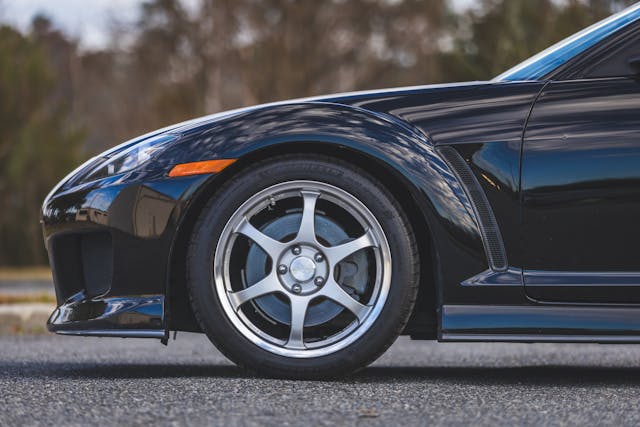
With the oldest U.S.-market cars now 20 years old, the RX-8, once merely a used sports car, is now an emerging enthusiast collector car. In one key respect, that’s a very good thing—these cars appreciate an owner who will keep up on maintenance (making them not altogether different from revered sports cars that wear more prestigious badges). This means tending to the service schedule, checking the oil regularly, and changing/adding it at regular intervals—the RENESIS engine injects oil into its chambers to help lubricate its apex seals. It also means managing little quirks, like letting the engine warm up fully before shutting it down, and periodically—this one will be hard, I know—winding it all the way out. These engines do better when exercised.
Early cars encountered some issues, including failing ignition coils and catalytic converters, most of which would likely have been addressed on a surviving car. Later examples benefited from revisions to the oil injection system that helped increase longevity and accommodate owners who treat the rotary like a piston engine. If you fall in love with the RX-8 (and there’s a lot to love), find one with a solid stack of receipts, then get out there and enjoy it.
While the RX-8 is not yet in the Hagerty Price Guide, Hagerty does insure the model. Over the last four years, there’s been a steady uptick in inquiries, and average values continue to rise (to just under $14K in 2024) even as the market has receded. RX-8 buyers seeking quotes are predominantly millennials at 29 percent, followed closely by Gen X with 28 percent and Gen Z at 26 percent. Today’s buyers saw the RX-8 when new, drove it in a video game, heard that slogan, and have decided to understand for themselves what the excitement’s about.
Even with an SCCA-prepped Miata in my barn and thousands of hours in Mazda products from this era, my drive in this RX-8 was a welcome refresher on what Mazda meant with Zoom Zoom—it was a reminder of how much personality and execution matter. The RX-8 is a car for anyone who values character and loves a good dance partner, and it still lives up to the promise of Mazda’s memorable slogan.
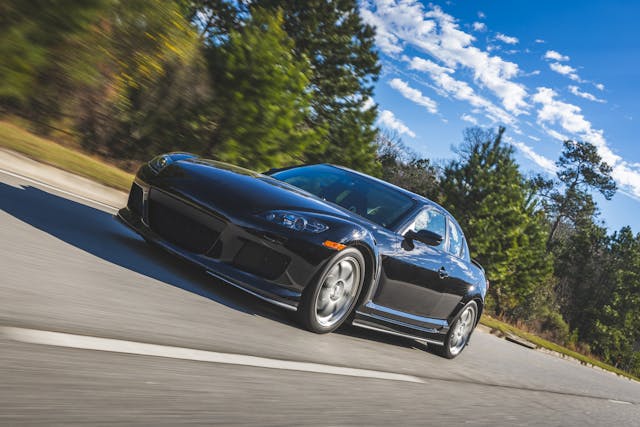
***
Check out the Hagerty Media homepage so you don’t miss a single story, or better yet, bookmark it. To get our best stories delivered right to your inbox, subscribe to our newsletters.
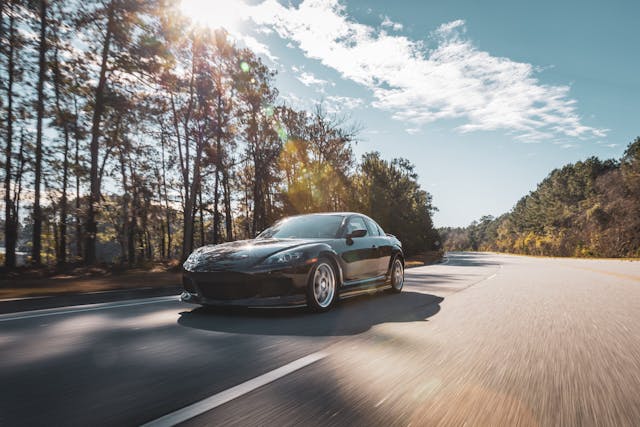


The Rotary cars were the most perfect imperfect cars. They had their faults but they were always interesting.
The RX8 while it found some refinement and some new tricks the second Gen RX7 was the peak. It has it all and the styling was spot on. Most Asian cars can be quirky like the RX8 but the second gen took the original and updated it well. I think it never got the attention it should have.
And the 2nd-gens make excellent race cars. Used to be quite a few in my class and they were almost always at the pointy end of the field.
As a previous owner of an ‘89 GTU I couldn’t agree more. It had its quirks but it was the best car I’ve ever owned.
I’ve never driven an 8. It does however sound like it would be much as I would expect ( and I mean that in a good way). While I applaud Mazda for producing them, it always seemed to me that they didn’t go far enough out on the branch.The…two and a half door?..configuration was a novel approach but other than that a little too conventional for a sports car sporting a rotary. They could / should have gone from the 7’s Zoom-Zoom- Zoom to Zip-Zip-Zipty, if you know what I mean. As it was, the 8 ended up being in a strange slot having to compete with the Speed3 and the 5 on the showroom floor. And the RX with its screaming 9000 rpm Wankel might have benefited from being touted as the ‘base’ engine in Indy Lights. All raced out, an – ‘I want one’ sound especially on an oval.
Bought my RX8 new in 2004, has just over 200000kms on the clock now! From new it was my summer car and its very easy to live with.
It’s a real joy and gives a truly unique driving experience. Engine is so smooth, gearbox is direct, and the brakes are above all for the period. One thing most do not discuss is the totally adjustable suspension from the factory.
If you enjoy back road rhythm driving this car will not disappoint you. It’s got enough power to make it interesting and won’t get you thrown in jail for enjoying it.
Treat your RX8 well and it won’t let you down.
I too had a 2004 RX-8 and agree 100%.
The RX-8 was a great driving car but not enough for me to forget the 3rd generation RX-7. That car looked great, handled great and sounds great. I considered buying one but decided I don’t understand spinning doritos enough compared to pistons.
While “zoom-zoom” was a catchy tag line, I remember another Mazda commercial using Linda Ronstadt’s “Just one look, that’s all it took” line that was a real winner!
‘ Just One Look ‘ was a catchy diddy. But the original was sung by Doris Troy in 63. It also did very well on the charts.
MY adventure into rotaries began with a $50 RX4. Wouldn’t go over 30mph and you had to keep feet on gas and brake to prevent stalling. Discovered a burned out gasket was the cause, but it was not available from Mazda or anywhere else, so I had to make one myself. Ran great afterwards. I was enticed and bought 2 non running RX7s afterwards. Loved the handling. No torque off Idle, but winds up quickly. Fun track car.
I’m trying to remember the Mazda ad that was something about “A piston engine goes boing boing boing boing but the Mazda goes hummmmm”. Anyone else remember that or am I crazy?
I’ve owned three Mazda rotary-powered cars: 1976 Cosmo, 1984 RX-7 GSL-SE, 1988 RX-7 convertible. Loved them all. I test drove a 1993 RX-7 and it was a blast to drive, but decided it wasn’t practical at the time (even though it was extremely tempting).
Quat – trying to remember, I have a thing for jingles. – ” I took my ( wife? but I’m hearing girlfriend ) and went for a ride… and all she could hear was that rotary engine whinnne… Piston engine goes, boink ba boink ba boink ba boink…but the Mazda goes hmmmmm.” Anyone else have a thing for rotary valve engines? An interesting concept never fully developed.
I loved my ’04 GT when it wasn’t having problems. Got it for $500 from someone who didn’t know the ins and outs of owning a rotary and gave up on it. Owning one IS a learning experience.
The car was the best handling car I have ever driven. I could take freeway exit ramps at 70 MPH without slowing down and little tire squeal. Even though rotaries are notorious for lacking torque, it pulled hard in 1st – 3rd from 4000 RPM to redline. Really fun car to drive!
Ran great for about 4 years and then the problems began…. 1st the electric power assist in the steering would cut in and out and finally died. Then the HVAC system quit working and the entire center dash pod with the HVAC & stereo had to be replaced. The final blow was when for no apparent reason, the engine started running in “limp mode” (to prevent damage). The car was basically undrivable at that point so I sold it for $1000 with 73K on the clock. The engine was mechanically sound but there were to many possible electrical issues to address for me to buy & try my way to fix and my other cars took priority.
I have to wonder how great they were/are. I’ve seen so many for sale cheap owners have had nothing but problems and just want to dump them. Considered if it would be worth fixing